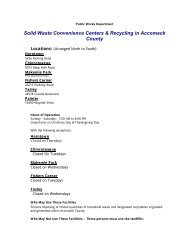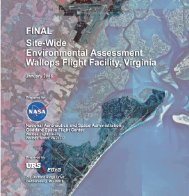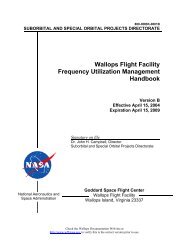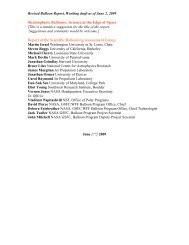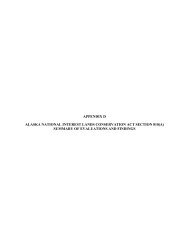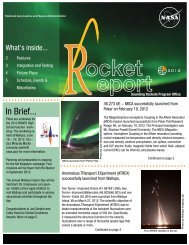Alternative Energy Draft EA - NASA Visitor Center at Wallops Flight ...
Alternative Energy Draft EA - NASA Visitor Center at Wallops Flight ...
Alternative Energy Draft EA - NASA Visitor Center at Wallops Flight ...
Create successful ePaper yourself
Turn your PDF publications into a flip-book with our unique Google optimized e-Paper software.
Affected Environment<br />
Wachapreague and Fisherman’s Island) surveyed during spring migr<strong>at</strong>ion can be more than<br />
12,000. Fall migr<strong>at</strong>ing Red Knots arrive again during the second week of July with the peak<br />
occurring sometime from l<strong>at</strong>e July through the end of August; peaks counts <strong>at</strong> WFF <strong>at</strong> this time<br />
of the year are 100 to 200 birds (Vaughn 1993).<br />
During the 2009 migr<strong>at</strong>ion season, flock sizes of 100 to 145 birds were observed on Ass<strong>at</strong>eague<br />
Island. In l<strong>at</strong>e May 2009, flocks of 5 to 30 individuals were observed on south Assawoman<br />
Island. On May 8, 2009 USFWS observed a flock size of almost 1,300 individuals on north<br />
<strong>Wallops</strong> Island. In l<strong>at</strong>e May 2009, flocks of approxim<strong>at</strong>ely 20 to 200 Red Knots were observed<br />
on the beach <strong>at</strong> North <strong>Wallops</strong> Island.<br />
The Red Knot principally uses marine habit<strong>at</strong>s during migr<strong>at</strong>ion. Coastal habit<strong>at</strong>s providing<br />
sandy beaches to forage along the mouths of bays and estuaries are preferred. Red Knots are also<br />
known to use tidal fl<strong>at</strong>s in more sheltered bays or lagoons in search of benthic invertebr<strong>at</strong>es or<br />
horseshoe crab eggs.<br />
Peregrine Falcon<br />
The average adult Peregrine Falcon has dark black plumage above, with much graying on the<br />
sides, with extensive spotting and barring. Popul<strong>at</strong>ions nesting in northern l<strong>at</strong>itudes are highly<br />
migr<strong>at</strong>ory. The Atlantic Coast from New Jersey to South Carolina and the barrier islands of the<br />
Texas Gulf Coast are important feeding areas for long-distance migrants. Peregrine Falcons are a<br />
diurnal raptor and are active year round. They feed primarily on medium-size birds up to small<br />
w<strong>at</strong>erfowl and rarely prey on small mammals, lizards, and fish. Peregrine Falcons are known to<br />
occur in Accomack County, VA. A nesting pair with fledglings was documented <strong>at</strong> WFF in 2005<br />
and 2009.<br />
Gull-Billed Tern<br />
The Gull-billed Tern is a stout, medium sized, white, blunt-billed bird th<strong>at</strong> feeds in the marshes<br />
and adjacent coastal uplands of the southern and Gulf coasts of the United St<strong>at</strong>es. Gull-billed<br />
Terns migr<strong>at</strong>e to the eastern U.S. breeding areas usually in mid-April and the adults typically<br />
depart in l<strong>at</strong>e July or early August. There are documented occurrences <strong>at</strong> CNWR and Fisherman<br />
Island N<strong>at</strong>ional Wildlife Refuge and all known breeding colonies in Virginia are loc<strong>at</strong>ed on the<br />
barrier islands of the Eastern Shore.<br />
Bald Eagle<br />
The Bald Eagle is a raptor known for the characteristic white head, white tail, and a large bright<br />
yellow bill in adult birds. Bald Eagles migr<strong>at</strong>e widely over most of North America, and most<br />
eagles th<strong>at</strong> breed in the northern United St<strong>at</strong>es move south for the winter. Special habit<strong>at</strong> fe<strong>at</strong>ures<br />
for Bald Eagles include standing snags and hollow trees. Breeding habit<strong>at</strong> most commonly<br />
includes areas close (within 4 kilometers) to coastal areas, bays, rivers, lakes, or other bodies of<br />
w<strong>at</strong>er th<strong>at</strong> reflect the general availability of primary food sources. Bald Eagles avoid areas with<br />
nearby human activity and development. Bald Eagles are documented <strong>at</strong> the CNWR and<br />
environmental scientists discovered a nesting pair of Bald Eagles within the northern section of<br />
<strong>Wallops</strong> Island in July 2009.<br />
72




